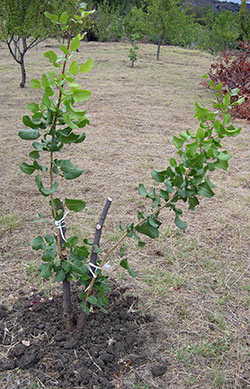Bronte's Pistachio
The Plant  The Pistachia vera is a plant not hermaphrodite of Persian origin, with a short trunk similar, in its appearance, to the fichus. The Pistachia vera is a plant not hermaphrodite of Persian origin, with a short trunk similar, in its appearance, to the fichus.
The pistachio is a very durable plant (lives from 200 to 300 years); develops very slowly and can produce only after nearly ten years from its being grafted. The one of Bronte presents peculiar characteristics that distinguish it from other arboreal species of agricultural interest or of the same pistachio cultivated in other Sicilian areas (Caltanissetta or Agrigento areas) or foreign (Middle East, Greece or California and Argentina). The tree, resinous, with a rich and ample foliage and hanging bunches of fruit doesn't grow higher than 5 meters. Has very deep roots, a brief trunk, contorted, with a yellow-reddish bark that becomes gray when the plant is adult and with deciduous and leathery leaves. The fruit presents itself in bunches similar to those of the cherry tree, but with a greater number of fruit that has a resinous and rubbery husk, white-reddish in color, and that, when ripe, wraps up in a very resistant wooden shell. The pistachio orchards (for the Bronte folks, the "lochi") are cultivated prevalently over nearly 3.000 hectares of lava land, with a very limited arable spaces, mixed to sites completely rocky, of little agronomic value, with deep slopes not easily accessible. Over such ground grows spontaneously and adapts itself an arboreal species, the terebinto ("pistacia terebinthus"), a very rustic plant resistant to drought.  Has a root system very deep and able to make its way through the cracks of the lava rocks. Has a root system very deep and able to make its way through the cracks of the lava rocks.
The terebinth, locally called "scornabecco" or also "spaccasassi", is utilized as graft carrier of the pistachio plant ("pistacia vera"). It is rightly thought of what gives the best product, resistant to drought and the right kind that produces the smallest number of empty fruits. Un arboreal transformation that must be considered fruit of the work of brontese generations, carried on with patience and with techniques handed over from father to son, forced to cultivate the lava to survive. Lacking fertile land -the majority of which belonged to the Hospital, the Duchy and few others - the Brontese peasant, during centuries of hard work, was compelled to cultivate the stony lava lands, so changing bare lava castings in pistachio orchards, producing high quality fruits greatly appreciated in European markets. The plant found its ideal climate, predominant in the areas around mount Etna, at an altitude of about 400 t0 700 meters above sea level, with temperatures of about 12° in Spring, and about 27° during July-August for ripening, with sporadic stormy rain to favor the full ripening of the fruit. Unfortunately the typology of the rocky land has always prevented the introduction of any type of mechanization consequently the cost of production remains fairly high.  Even now, the only machines used in some farms are the grass cutter, the rotary hoe and some motorized-pump of limited potency. Even now, the only machines used in some farms are the grass cutter, the rotary hoe and some motorized-pump of limited potency.
For the rest prevails always the toil of the farm worker, the use of the hoe, the rake, the sickle and the spraying pump carried on the shoulders. The pistachio plant has an ample and deep root system, a trunk usually short and contorted, with long, resinous branches and a not very expanded foliage, sparse with leathery and velvety leaves, hairy on the edges and on the stalk. The pruning of the plant is done between December and February. All dried branches, suckers and weakened branches, due to excessive fruit production, are removed. On the even years, when there is no picking, is done also what is called the green pruning: the flowering buds in the extensions of the previous year are removed by hand. So to avoid any vegetative activity and preserve the substances for the following year. Between April and May the blooming takes place with purple, odorless flowers, gathered in panicles of inflorescences.
|